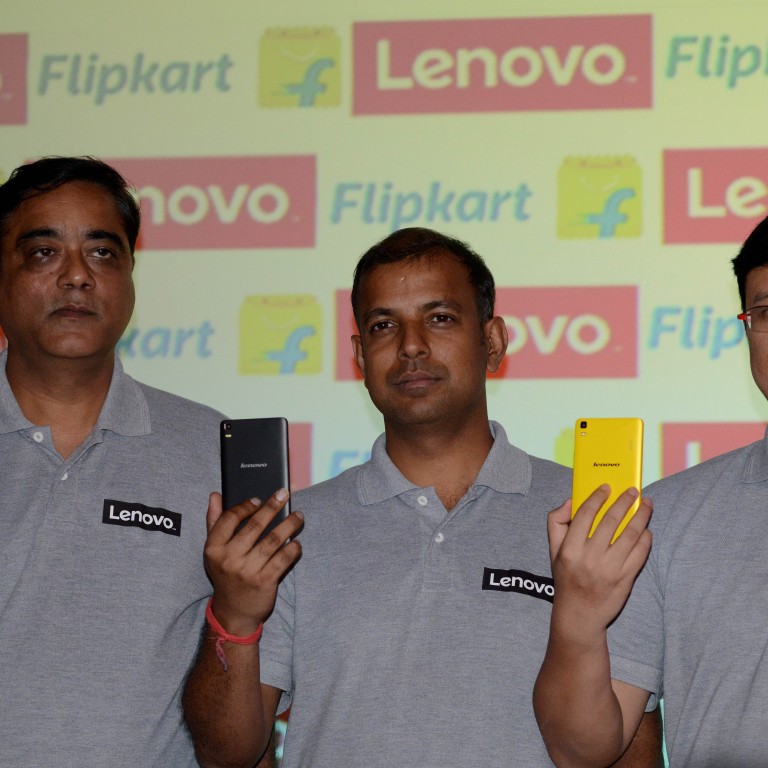
Lenovo leads Chinese rivals in race to tap India's love of cheap smartphones
Beset by slow growth in their home market, Chinese mobile phone suppliers are looking to ramp up their expansion in India as the country’s appetite for low-cost smartphones continues to develop.
Price will be the chief point of competition vis-à-vis domestic brands in India, analysts say. India is the world's fastest-growing and third-largest smartphone market, with handsets under US$100 doing especially brisk business.
Chinese computer giant Lenovo Group, telco equipment maker Huawei Technologies, consumer electronics start-up Xiaomi, Gionee Communication Equipment and Oppo Electronics are among the major Chinese smartphone suppliers expected to pursue more aggressive sales and marketing programmes in India this year.
"They're taking the Chinese smartphone food fight abroad, where there is still growth and profits to be made," Alberto Moel, a senior analyst at Bernstein Research, told the South China Morning Post.
"The Chinese smartphone makers, while still relatively small in India, had an impressive 214 per cent revenue growth in the first quarter. They grabbed 12 per cent market share, from 6 per cent a year ago," Moel said.
"We expect further market share expansion in the next few years."
Data from Counterpoint Technology Market Research showed that Lenovo, with a 5.2 per cent share, was the sole Chinese supplier among the top-five smartphone brands in India in the three months to March.
Samsung Electronics took the top spot, followed by Indian players Micromax, Intex and Lava.
Moel said India's smartphone market is characterised by a "low average selling price, slow technology migration and high reliance on the retail channel".
In a report, Bernstein predicted that by 2019, some 51 per cent of the continent's smartphone market will consist of handsets that cost less than US$100, up from 42 per cent last year.
"We expect the average selling price [in that low-cost smartphone segment] to hit the US$50 mark at some point," Moel said.
Unlike in mainland China and many other markets around the world, mobile network operators in India provide few smartphone subsidies.
Bernstein estimated that 85 per cent of smartphone sales in India last year were bought from retail channels, including e-commerce platforms such as Flipkart and Amazon India, because India still has so many people living in remote villages.
This situation has made the market more price-sensitive, compared with the US, where smartphones are heavily subsidised.
Most of the smartphone models sold in India last year were still 3G. Strategy Analytics forecast that 4G will represent only 27 per cent of Indian smartphone sales in 2019.
"It will take time [for 4G smartphone demand to develop] because India's telecommunications infrastructure lags behind those of other markets," Moel said.
Motorola sold about 3 million smartphones in the market last year, helped by transactions made through e-commerce partner Flipkart.
In March, Xiaomi committed to make further investments in India, and start producing its smartphones there early next year.
“We want to invest deeply in this market,” Hugo Barra, Xiaomi’s vice-president of international operations, said at the time.
“We want to have a significant amount of research and development done here – not only for India, but for the rest of the world.”
Oppo has plans to establish more than 200 service centres across India, while Gionee is looking to roll out 750 of its own technical support centres this year.
Linda Sui, a director at technology consultancy Strategy Analytics, has predicted that India will overtake the United States as the world's second-largest smartphone market by 2017.
She forecast 174 million smartphones will be sold in India in 2017, up from an estimated 118 million units this year and about 82 million last year.
"India's growth is being driven by low smartphone penetration, expanding retail availability of devices, wealthier middle-class consumers, and aggressive promotions from local smartphone brands like Micromax," Sui said in a report.

